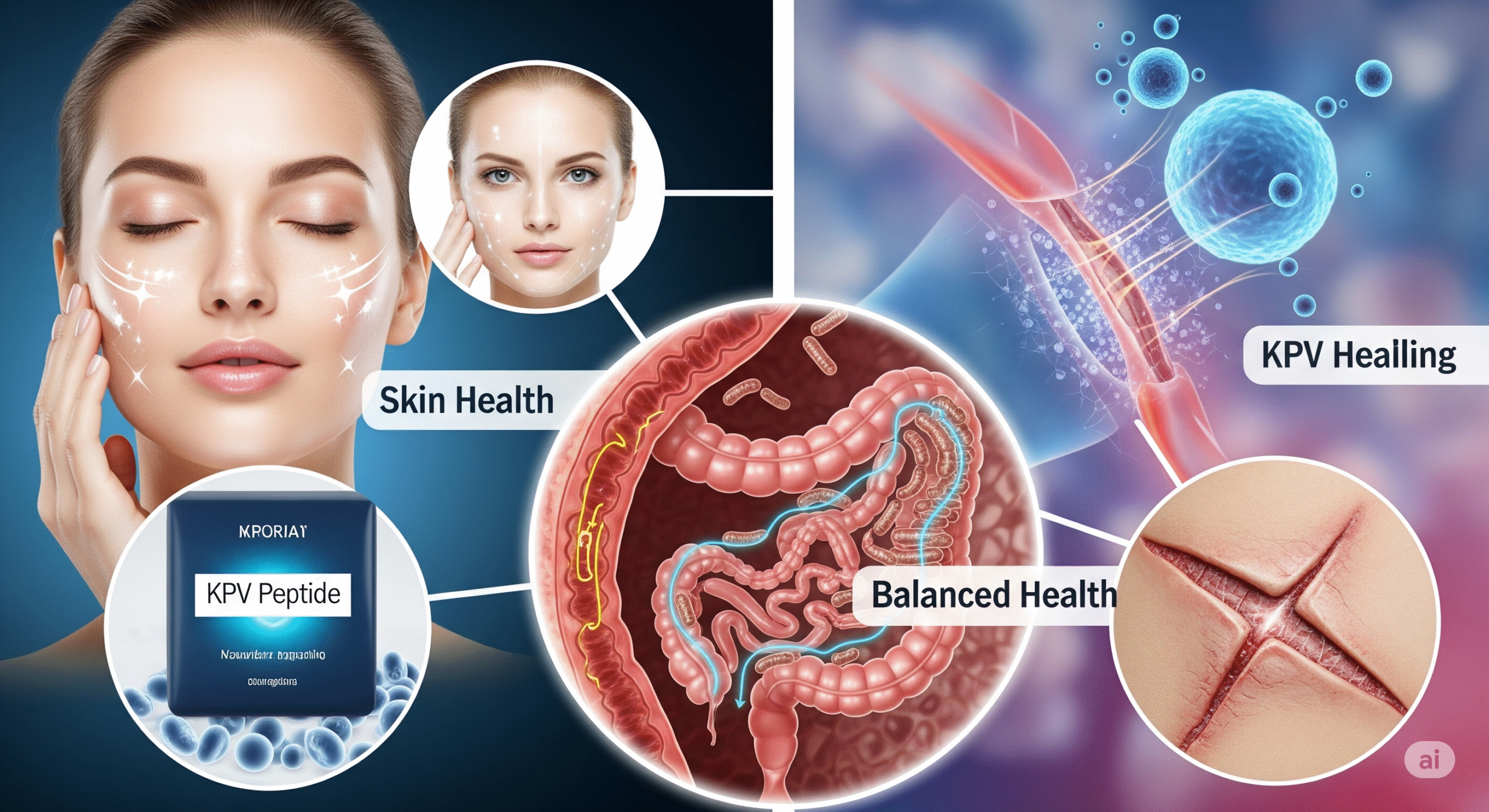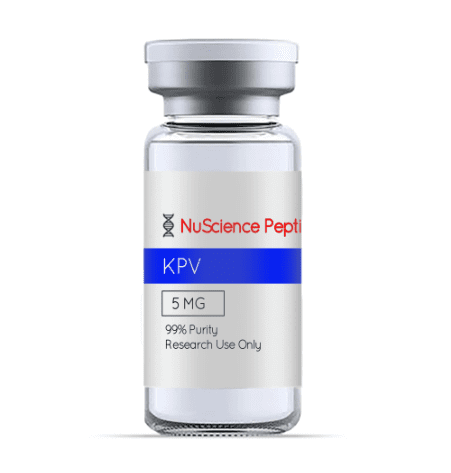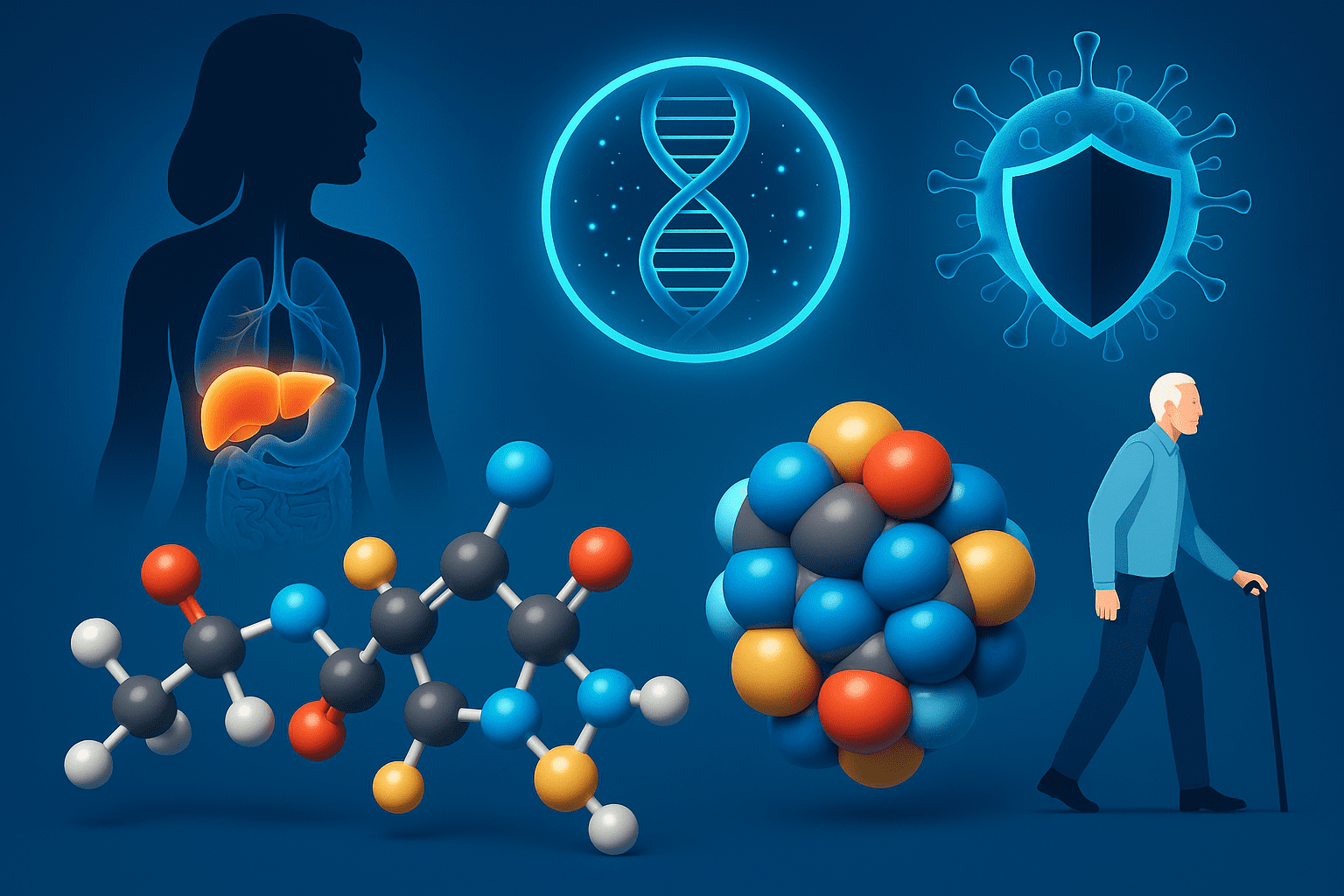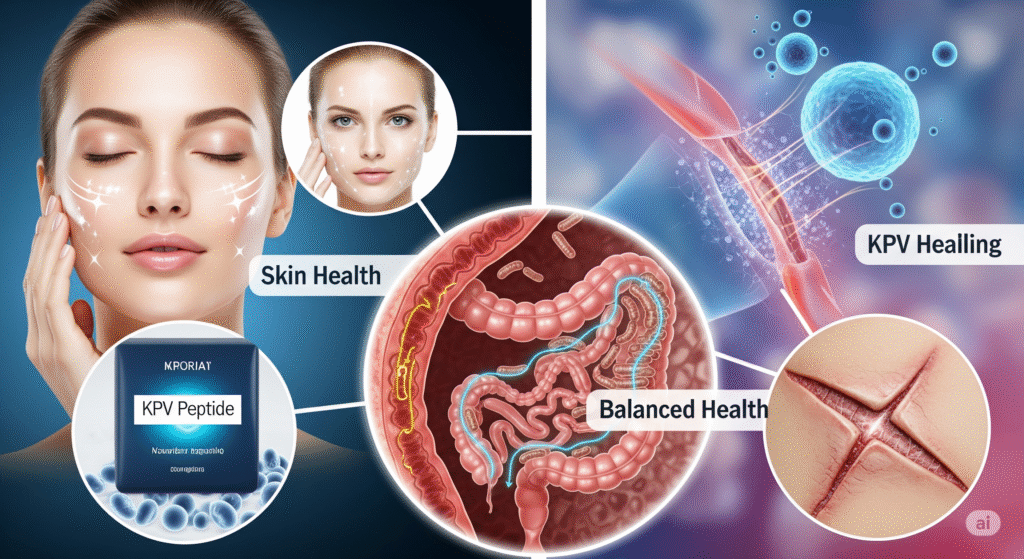
Can a tiny 3-amino acid peptide really calm your gut, clear your skin, and speed up healing?
That’s exactly what KPV peptide benefits are proving in the world of science and skincare.
In this article, we’ll uncover what KPV is, how it works in your body, its real benefits, possible side effects, and the best place to buy it for research use.
Let’s break it down step by step—so you can see if KPV is right for you.
Now, let’s dig into what KPV really is.
Part 1. What Is KPV Peptide?
You’ve probably never heard of KPV before, but it’s actually a tiny thing made of just three building blocks including lysine, proline, and valine. It’s a small piece taken from something much bigger in the body, a hormone called alpha-MSH. Funny enough, even though it’s a fragment, it still carries some powerful effects from the original hormone.
One cool thing about KPV is that, it helps calm down inflammation. That means it can be super useful if you’re dealing with irritated skin or gut problems. And here’s the best part—it doesn’t mess with your skin tone like the full hormone can. No weird dark patches. Just healing, plain and simple. (Pawar et al.2017)
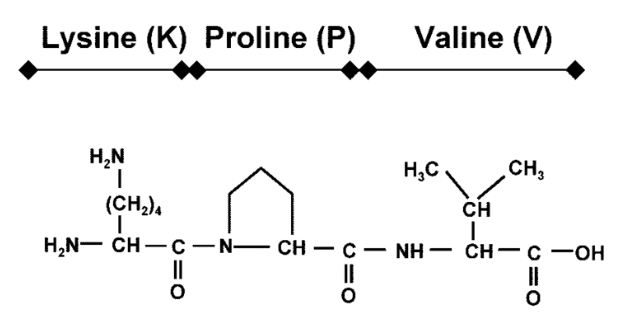
Structure of KPV Peptide
The Problem With KPV
There’s one big issue with KPV. It’s very water-based and doesn’t pass easily through the skin. When tested on skin without any help, almost none of it could get in. This made it hard to use KPV in creams or lotions.
How Scientists Improved It
To fix this, scientists tried new ways to push KPV through the skin. They used
- Microneedles (tiny needles)
- Iontophoresis (a mild electric current)
- And both together
Here’s what they found:
- Microneedles helped KPV go through the skin better.
- Iontophoresis did even more—about 8 times better than microneedles.
- But using both together gave the best results. It made KPV go through the skin 35 times more than microneedles alone!
This was a big step forward.
Next, let’s explore how KPV actually works inside the body to fight inflammation.
Part 2. How KPV Works (Mechanism of Action)
KPV works deep inside your cells to calm inflammation. But how does it do that? Let’s break it down in the simplest way.
When the body faces inflammation, a special protein called NF-κB becomes active. This protein moves into the cell’s center (the nucleus) and tells it to start making more inflammation signals like IL-8 and eotaxin. These chemicals call more immune cells to the area, which makes the inflammation worse.
KPV steps in and stops that from happening.
What Exactly Does KPV Do?
KPV works like a smart blocker—it stops inflammation signals before they can do any harm.
- It blocks the movement of NF-κB into the nucleus.
That means the inflammation signals never get turned on.
- It keeps a helper protein called IκBα stable.
Normally, IκBα gets broken down during inflammation. But KPV helps protect it. This is important because IκBα holds NF-κB in place and stops it from causing damage.
- KPV gets inside the nucleus itself.
Once it’s there, it competes for space with a part of NF-κB (called p65RelA). This stops the inflammation process before it starts.
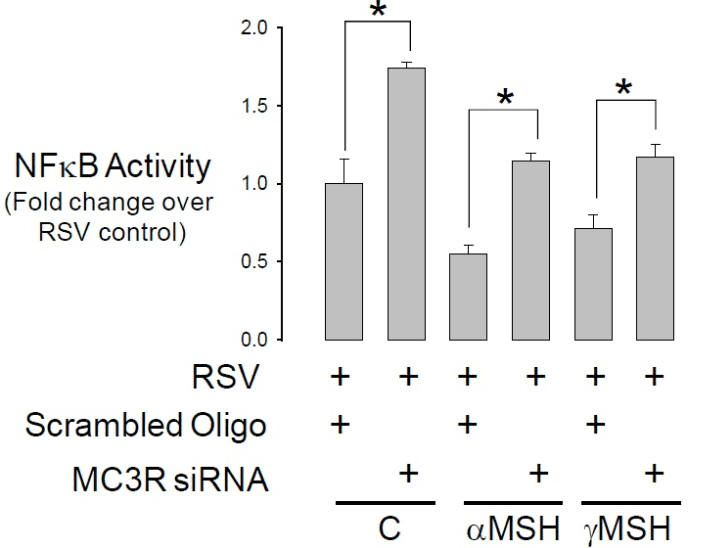
Inhibition of NF-κB activity
How Does KPV Get Into the Cell?
KPV doesn’t need to work through hormone receptors like other similar peptides. It enters the cell using a natural transporter called PEPT1. This is like a door in the cell wall made just for small peptides like KPV. Once inside, it gets straight to work.
Important Notes
- KPV’s action doesn’t affect your DNA or change your genes. It works gently without causing long-term effects.
- Its small size and water-loving nature help it move easily once it’s inside the cell.
- KPV’s effects aren’t limited to one area—it can help with both local and full-body inflammation.
Let’s now break down the real-life health benefits people may get from KPV.
Part 3. Top KPV Peptide Benefits
From healing skin to supporting gut health, KPV peptide has shown big results in many areas. Let’s explore the main benefits one by one—and see why KPV is getting so much attention today.
-
Anti-Inflammatory Power
One of the biggest benefits of KPV is its ability to calm inflammation.
When your body is injured or irritated, it sends out chemical messengers that start inflammation. This is a natural part of healing. But sometimes, the body overreacts—and that leads to chronic problems like eczema, psoriasis, or gut issues.
KPV can step in and stop this overreaction.
In research, KPV was shown to
- Reduce the release of harmful signals like interleukin-1β, which is often responsible for redness, pain, and swelling. It does this without needing to bind to hormone receptors, which is rare.
- Not cause skin darkening or pigmentation, which is common with its parent hormone α-MSH.
Doctors often use steroids for treating skin inflammation, but long-term steroid use can lead to serious side effects. That’s where KPV stands out—it offers similar anti-inflammatory effects without the risks of steroids.
Researchers also found that
- When KPV was used on the skin, it needed help to get through.
- They used tiny microneedles and a soft electric current called iontophoresis to push it in.
- With these methods, the skin absorbed much more KPV—up to 35 times more than with microneedles alone!
So not only is KPV powerful, but with the right delivery methods, it’s also highly effective.
-
Gut & IBD Support
KPV doesn’t just help with skin—it also shows strong promise for gut health, especially in people with inflammatory bowel diseases (IBD) like ulcerative colitis.
In ulcerative colitis, the inner lining of the large intestine becomes inflamed. This can lead to pain, diarrhea, and other daily problems. KPV has shown the ability to:
- Target the inflammation
- Help doctors tell the difference between chronic and acute colitis, which is important for correct treatment.
What Research Shows?
In a recent study, scientists used a special KPV-based compound to see how the peptide acts inside the gut. They discovered that KPV connects with a transporter in the intestine called PepT1. This transporter becomes highly active during chronic colon inflammation, meaning:
More KPV is pulled into the inflamed tissue, right where it’s needed most.
Once KPV enters the cells, it travels to the nucleus, calming inflammation by blocking harmful signals.
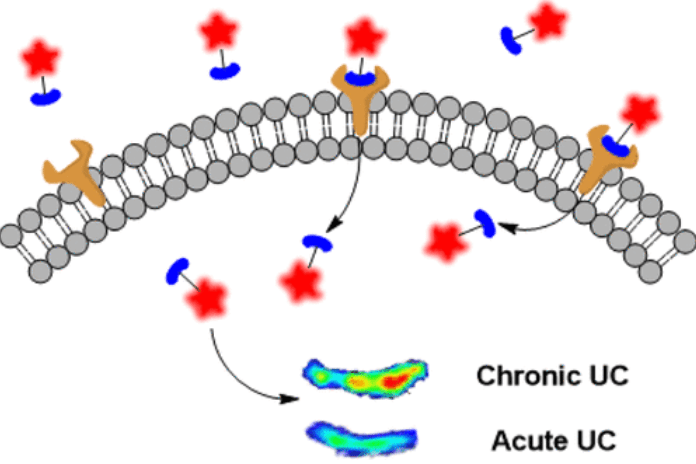
Chronic and Acute Ulcerative Colitis
Safer Way to Monitor IBD
Researchers even created a glowing version of KPV. This allowed them to:
- Watch KPV move through the gut lining,
- Track it as it reached inflamed areas, and
- Do all this without damaging the tissue.
This method is safer than traditional gut biopsies and may offer a better way to monitor and manage IBD over time.
-
Wound Healing & Skin Health
Wound healing is not just about closing a cut. It’s a step-by-step journey your body takes to repair the damage. It goes through three key phases: inflammation, rebuilding (proliferation), and finally reshaping (remodeling).
This process needs many different skin cells to work together—like keratinocytes (skin builders), fibroblasts (collagen makers), and even immune cells. What makes KPV peptide so interesting is how it interacts with these cells to help healing happen faster, cleaner, and with less scarring.
Why KPV Works So Well?
KPV comes from a bigger hormone called α-MSH. That hormone is known for helping with skin color, but KPV is a smaller piece that doesn’t change your skin tone. What it keeps is the good stuff—like calming inflammation and fighting off germs.
Many skin cells, including fibroblasts and keratinocytes, carry special receptors (called MC1R) that respond to melanocortin peptides like α-MSH. Even though KPV doesn’t bind to these receptors the same way, it still manages to reduce inflammation and protect the skin.
Scientists believe that KPV helps wounds heal faster by doing three main things:
- Fighting off inflammation
- Protecting skin cells from damage
- Reducing the risk of infection
And the best part? It does all this without causing any dark spots or changes in skin color.
Rebuilding Skin Without the Downsides
Most treatments for wounds either reduce inflammation or help the skin grow back. But KPV can do both. That’s rare.
- Steroids are often used to calm inflammation, but they can thin out your skin or slow down healing when used too long.
- Antibiotics fight infection, but they don’t help with repair. KPV stands out because it supports the skin in multiple ways—without serious side effects.
Researchers even looked at how KPV affects skin cells in lab models and animal studies. The results were encouraging. KPV helped reduce damage, sped up recovery, and didn’t cause pigmentation or irritation.
-
Antimicrobial Effects
Scientists have been exploring KPV structure to see if it can work like other antimicrobial peptides (AMPs), which fight bacteria and fungi naturally.
In one detailed lab study, researchers designed several small peptides, including ones based on parts of KPV. They tested how well these peptides could fight germs, and the results were quite promising.
How Does It Work?
Most bacteria have negatively charged outer layers. The KPV-based peptides carry a strong positive charge. This helps them stick to bacterial surfaces. Once they attach, they can break the membrane and kill the bacteria.
Even more interesting, these peptides don’t harm human red blood cells. That makes them safer than many regular antibiotics or older antimicrobial agents.
KPV-Based Peptides in Action
One version, called KPV-13, was specially created by combining parts of natural antimicrobial peptides and a section from the original KPV. This hybrid peptide showed strong antibacterial effects, especially against:
- Staphylococcus aureus
- Staphylococcus epidermidis
- Escherichia coli
- Klebsiella pneumoniae
- Pseudomonas aeruginosa
These are some of the most common germs that cause infections in hospitals and homes.
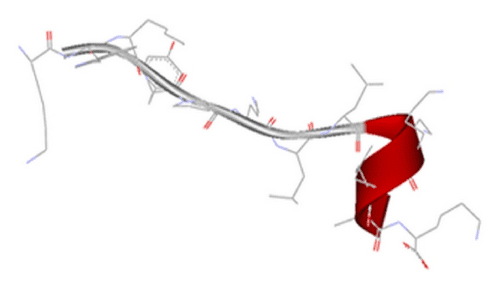
Secondary structure of KW-13
The way KPV peptides kill bacteria is also unique. Scientists used a microscope to watch them in action. They saw that the bacterial walls cracked and burst after treatment. The cells completely broke apart—proof that the peptide works by destroying the bacterial membrane.
(Reference)
But how safe is KPV really? Let’s take a closer look.
Part 4. KPV Peptide Side Effects & Safety
KPV peptide is known for being gentle on the body. But just like anything else, it may still have some side effects. Most users don’t report any serious problems. But it’s always smart to know what to expect before using it.
What Makes It Safe?
KPV is a small, natural peptide. It’s already found in the body as part of a larger hormone (alpha-MSH). This makes it much less likely to cause trouble compared to many drugs or synthetic chemicals.
Peptides like KPV are also:
- Easily broken down by the body
- Non-toxic at low doses
- Not stored long-term in tissues
- Water-soluble, so they pass through the body quickly
All these things make KPV a low-risk option for most healthy adults.
Common Experience: No Issues at All
Many people use KPV without any problems. In fact, some early users report better skin, less gut pain, and faster wound healing—without any downsides.
But that doesn’t mean everyone is the same. A few mild effects have been noted.
Possible Side Effects
Although rare, here are a few things that might happen in some people:
|
Symptom |
What It Might Feel Like |
|
Redness or irritation |
May happen at the site of injection or cream |
|
Mild allergy signs |
Like itchiness, rash, or slight swelling |
|
Tummy trouble |
If taken by mouth, some users feel nausea |
|
Fatigue |
Some may feel tired or low-energy (very rare) |
These effects are usually mild and go away quickly. They don’t happen to everyone.
Who Should Be Careful?
Some people should talk to a doctor before using KPV including
- Pregnant or breastfeeding women
- Person with Autoimmune diseases
- People taking immune-modulating drugs
- The one having peptide allergies in the past
Now that we know it’s safe, let’s find out the best online shop for its purchasing.
Part 5. Where to buy KPV Peptide?
Want to buy pure and powerful KPV? Looking for fast delivery and trusted quality? Here we listed one of the best site that is known for it’s best results.
NuScience Peptides
A top-rated store for research peptides and trusted by many. They are not just a random seller. They are known for quality, speed, and customer care.
Here’s why people love shopping from NuScience Peptides:
- Lab-Tested Purity
Every peptide is tested in labs for maximum purity. No hidden fillers. No junk. Just clean, strong peptides.
- Same-Day Shipping
If you order before 12:00 pm EST, they ship your order the same day. Fast delivery right to your doorstep.
- Free Shipping Over $200
Orders above $200 get free shipping—no extra charges.
- Helpful Customer Support
Their support team is quick and friendly. If you have any questions, they are always ready to help.
- Trusted, Accurate Products
They care about honest research and clean formulas. From KPV to BPC-157, everything is made with care and quality.
KPV Peptide from NuScience Peptides
Check out their store today and find top-grade KPV that works. Click below and shop with full confidence.
Explore NuScience Peptides Now.
Conclusion
If you’re dealing with skin problems, gut issues, or slow healing, KPV peptide benefits are worth knowing. This small peptide helps lower inflammation, support recovery, and protect your body—all without major side effects.
It works gently and effectively, making it a smart choice for anyone looking for natural relief. From skin to gut, the benefits are real and backed by research.
Want to give it a try? NuScience Peptides offers clean, lab-tested KPV you can trust.
Visit NuScience Peptides now and see how KPV peptide benefits can help you.
DISCLAIMER
KPV peptide is sold strictly for research and laboratory use only. It is not approved by the FDA to treat, cure, or prevent any disease. This product is not for human or animal use, and should not be used as food, drug, cosmetic, or supplement. Always handle peptides with proper safety precautions. This article is for educational purposes only and does not give medical advice.
References
Böhm, M., & Luger, T. (2019). Are melanocortin peptides future therapeutics for cutaneous wound healing? Experimental Dermatology, 28(3), 219–224. https://doi.org/10.1111/exd.13887
Land, S. C. (2012). Inhibition of cellular and systemic inflammation cues in human bronchial epithelial cells by melanocortin-related peptides: Mechanism of KPV action and a role for MC3R agonists – PMC. International Journal of Physiology, Pathophysiology and Pharmacology, 4(2).
Pawar, K. (2017). Transdermal iontophoretic delivery of lysine-proline-valine (KPV) peptide across microporated human skin. Journal of Pharmaceutical Sciences, 106(7), 1814–1820. https://doi.org/10.1016/j.xphs.2017.03.017

